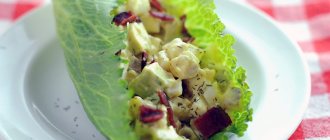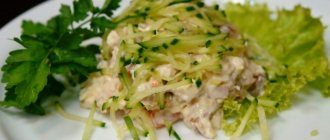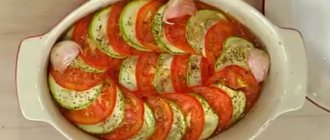Features of products for good vision
Vision restoration products are most often dark green or orange in color. Carotenoids, which are considered powerful antioxidants, give them their orange tint. They maintain visual acuity and prevent the development of eye diseases. Green foods contain zeaxatin and lutein. They protect the lens of the eye from oxidative processes and protect it from free radicals formed in the light.
A decrease in vitamins in the body leads to early deterioration of vision and deformation of the lens. It is advisable to replenish the supply of useful substances using sources of natural origin. It is extremely important to provide a regular nutritious diet. With the help of diet therapy you can achieve the following results:
- maintaining and enhancing visual acuity;
- strengthening blood vessels;
- prevention of cataracts and glaucoma;
- strengthening the eye muscles;
- moisturizing the mucous membrane of the eye;
- protection of the retina from ultraviolet radiation;
- increased color perception.
Foods rich in vitamin A are of primary importance in the fight for good vision.
To increase the effectiveness of foods designed to improve vision, you need to perform special exercises. You also need to limit the time you spend at the computer and watching TV. The quality of sleep and the stability of the emotional state are of no small importance in therapy.
Attention! If vision problems occur, you need to perform special exercises daily aimed at relaxing the muscles.
Spinach
Spinach protects the eyes from various diseases. It contains large amounts of lutein and zeaxanthin, as well as copper, zinc, phosphorus, potassium, magnesium, selenium, sodium and fatty acids. Spinach is very nutritious and contains vitamins A, C, E, K, B2, B6.
When green leafy vegetables are often eaten fresh, carotenoids and retinol accumulate in the tissues of the eye organs. As a result, destructive processes in the retina are stopped, stress is reduced under heavy loads on the eyes, including prolonged contact with a computer screen, and the process of normal functioning of the vision system is resumed.
In general, spinach has long been recognized by scientists as one of the most effective foods that help improve vision.
What foods are good for eyes and vision?
The action of products to improve vision is based on a rich vitamin composition. Fruits and vegetables are considered the most beneficial. Some of them contain a huge amount of carotenoids, vitamin A and tocopherol. Products containing phosphorus, zinc, copper and potassium are no less effective. They help prevent a number of serious diseases and maintain cell membranes. The list of foods that have a positive effect on vision includes:
- spinach;
- sea fish;
- broccoli;
- parsley;
- dairy products;
- carrot;
- pumpkin.
The berries retain their beneficial properties even when frozen. That is why they will be an excellent option for strengthening vision in winter. It is better not to heat treat fruits and vegetables.
Soy products also have a positive effect on vision. They contain vitamin E, which is necessary for maintaining sharp vision. To increase the supply of this substance in the body, it is enough to introduce soy meat or milk into the diet. Eggs are an equally important product. They contain a lot of minerals. Regular consumption of eggs helps to avoid the appearance of conjunctivitis and stye.
What foods are good for a child's vision?
Products to preserve vision should definitely be included in children's diets. The process of formation of the optic nerve is in its infancy. If the body does not receive the required amount of vitamins, the likelihood of developing serious diseases increases. Children whose parents are nearsighted or farsighted are at risk. A lack of nutrients at an early age can reduce vision and cause eye diseases. To prevent this from happening, you need to give your child more of the following foods:
- blueberry;
- avocado;
- salmon and shrimp;
- onion and garlic;
- citruses;
- eggs;
- potato.
We recommend reading: Potatoes: beneficial properties and contraindications
Blueberries and spinach are extremely beneficial for vision. To teach your child to eat these products, you can prepare smoothies based on them. Blueberries are added to porridge, cottage cheese and various desserts. To neutralize the sour taste, you can use it together with a sweet filling. Eggs and potatoes can be given to your baby in salads. Seafood is recommended to be served as pasta. Children should not be prohibited from chocolate. It contains flavonoids that strengthen the cornea and protect blood vessels.
Carrots are considered a rich source of fiber
What foods improve vision in teenagers?
According to medical data, the visual system is formed before the age of 18. Therefore, the diet in adolescence should be complete. Vitamin A has a significant effect on visual acuity. Its highest concentration is found in apricots, avocados, carrots and bell peppers. These products must be present in a teenager’s diet.
Thiamine, in turn, reduces intraocular pressure. Its highest concentration is found in grain products, liver and fermented milk products. To strengthen blood vessels, you need to add sources of ascorbic acid to your diet. It is present in large quantities in citrus fruits, cranberries, black currants and rose hips. To maintain visual function in excellent condition, it is advisable to limit the consumption of coffee, flour products, chips and sweet soda.
What foods improve vision in adults?
Products that support vision at the proper level do not need to be excluded by adults. The main sources of nutrients are fruits and vegetables. The richest source of vitamins is carrots. It can be replaced with sweet potato. The advantage of the vegetable is that it contains beta-carotene, which provides the body’s daily needs. Fruits and vegetables are perfectly absorbed by the digestive system and have a general strengthening effect. It is also necessary to ensure that there is a sufficient amount of greens in the diet. Spinach is considered the healthiest product.
Comment! Fruits, vegetables and herbs must be consumed without heat treatment.
What foods improve vision in the elderly?
Vision can also decrease due to age-related changes. Preventive measures should be taken care of long before problems arise. Older people are most likely to develop cataracts and glaucoma. Eating foods to improve your vision after 40 years of age will help you avoid these diseases in the future.
The emphasis should be on vegetable salads. It is necessary to give preference to recipes containing fresh carrots, pumpkin and white cabbage. For dinner, nutritionists recommend eating boiled fish. It is rich in omega-3, which is necessary for the proper functioning of the visual organs. It is recommended to eat a handful of pistachios during snacks.
As you get older, your risk of experiencing macular degeneration increases. This problem can be avoided by consuming foods rich in zinc. These include beef, eggs and carrots. The first option can be replaced with chicken breast or pork loin.
For better digestibility, protein foods must be consumed together with vegetables.
Eye diseases: vitamin deficiency
Let's start with the last principle. Vitamin deficiency is common to most women these days. For eye diseases, the body requires certain vitamins, which we mentioned above. Let's remember that vitamin A is found in:
- carrots,
- melon,
- tomatoes,
- salad,
- green peas,
- green onions,
- cottage cheese,
- liver
Vitamin B in:
- in vegetables,
- mushrooms,
- fermented milk products.
Vitamin C in:
- in the rose hips,
- potatoes,
- sauerkraut,
- citrus fruits.
Include these foods generously in your diet.
Carrot juice perfectly nourishes the entire eye system. It is the richest source of vitamin A. It is quickly and well absorbed. You can drink this juice whenever you want, but twice a year you need to drink carrot juice as a medicine, in a course. A glass of juice every morning for a month.
By the way, carrot juice also strengthens the nervous system, treats cancer at an early stage and can bring the entire body into a vigorous state. During seasons when carrots lose their juiciness and are no longer suitable for juice, drink carrot decoction. It can also form the basis of vegetable soups. It should not be forgotten that
- stewed carrots,
- carrot salad,
- juice
It should be consumed with sour cream or butter, since vitamin A is fat-soluble. A small spoonful of fat is enough.
Monotonous food not only reduces appetite, but is also difficult to digest. Nutrition must be complete in all components
For diseases of the eyes and optic nerve, ulceration of the cornea, cataracts and conjunctivitis, parsley juice is effective . It is one of the most potent juices, so you should not drink more than 30-40 ml per day. The amount of juice at one time should be no more than one tablespoon.
It is better to mix parsley juice with water or other vegetable juice. A mixture of parsley and carrot juice is extremely useful. The elements present in parsley juice are contained in such a combination that they help strengthen blood vessels, especially capillaries and arteries. Parsley juice is a potent remedy for restoring visual acuity, which is reduced when the eyes work hard.
Beetroot perfectly “refreshes” the eyes, cleanses the blood and, in general, the entire body . Two tablespoons of its juice should be added to the carrot-parsley juice mixture.
Apricots in any form have a positive effect on the blood vessels of the eyes
- natural
- fresh fruits
- juice
- dried - dried apricots and apricots.
Among the summer berries, blueberries improve vision . During the season you should eat at least 10 glasses. Blueberries retain their unique properties well in the form of raw jam. Blueberries should be ground in proportions: one glass of berries to one glass of granulated sugar. If the prepared blueberries are stored in the refrigerator, the portion of sugar can be halved.
Be sure to drink rose hips - it has no equal in terms of vitamin C content. Its daily use ensures the strength and elasticity of blood vessels.
People suffering from myopia should prepare hawthorn. It is rich in ascorbic acid and carotene. Dried hawthorn fruits, ground into flour and mixed with honey, can be eaten as jam. Dried leaves and fruits of hawthorn are good to use as tea leaves instead of tea.
Infusions of hawthorn and rosehip, blueberry juice and jelly, green tea should diversify your diet daily, making up about half of the liquid you drink.
Each meal should include fruits, vegetables, salads, and juices. Of all the cereal porridges, oatmeal and buckwheat are especially rich in vitamins, which are well absorbed and necessary for our eyes.
You should eat as little white bread and sweets as possible. Limit your salt intake, but by no means eliminate it from your diet completely.
Table of products for vision
Eye diseases are very difficult to treat. It is much easier to prevent their occurrence by ensuring the supply of nutrients. To do this, you need to follow the basics of proper nutrition. The list of products necessary to normalize vision is shown in the table:
| The product's name | Useful element that improves vision |
| Carrot | Vitamin A |
| Olive oil | Vitamin E |
| Grapefruit | Ascorbic acid |
| Salmon, herring, mackerel | Vitamin D |
| Eggs | Thiamine |
| Cashews, pistachios, peanuts | A nicotinic acid |
| Green vegetables | Riboflavin |
| Broccoli | Vitamin C |
| Dairy products | Vitamin B1 |
| Beef liver | Vitamin B12 |
| Turkey and chicken meat | Vitamin PP |
| Beans | Pyridoxine |
Rules for using products for vision
Products to improve vision for myopia can be consumed absolutely at any time of the day. The main thing is to combine them correctly to improve the absorption of nutrients. It is recommended to consume fruits before lunch, but grapefruit can also be eaten for dinner. Fish, meat and offal are eaten along with side dishes for lunch and dinner. Fermented milk products and nuts can be used for snacks. No less important nutritional rules for improving vision include the following:
- the diet should contain both proteins and complex carbohydrates;
- It is advisable to boil and steam products, avoiding frying;
- it is necessary to stop smoking and drinking alcoholic beverages;
- 50% of the daily diet should consist of fruits and vegetables;
- It is advisable to limit the consumption of sweet and fatty foods;
- it is necessary to protect the eyes from exposure to ultraviolet rays;
- it is necessary to abandon products containing E-additives;
- To enhance the effect of the diet, you should perform special gymnastics.
The number of meals during a therapeutic diet reaches 3-5 times. Breakfast should be taken no later than half an hour after waking up. In this case, it is advisable to eat protein foods or complex carbohydrates in the form of porridge. The last dose should not be taken immediately before going to bed.
Important! If changing your diet does not give the desired result, you should consult a doctor to select a medication.










